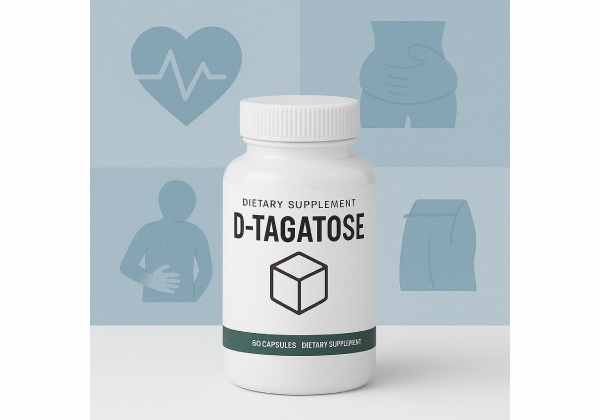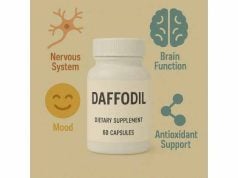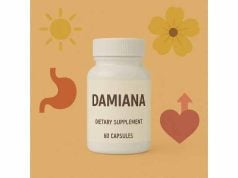
D-Tagatose is a “rare sugar” that tastes close to table sugar but behaves differently in the body. It delivers sweetness with fewer calories, produces a smaller rise in blood glucose and insulin, and can be fermented by gut microbes to short-chain fatty acids. Food makers use it in drinks, dairy, confections, and baked goods; consumers use it as a spoonable sweetener or as part of a lower-sugar diet. Early clinical trials suggest it can modestly lower HbA1c when taken with meals, and recent reviews highlight potential oral health benefits. Still, it is not a free pass: large single doses may cause bloating or diarrhea, and people with certain conditions should be cautious. This guide explains how D-tagatose works, where it helps most, how to use it day to day, and what to watch for.
Quick D-Tagatose Highlights
- Sweetener with smaller post-meal glucose and insulin rise compared with sucrose.
- May support modest HbA1c reductions at 15 g with meals (45 g/day).
- Typical daily use target: 10–45 g/day, divided with food.
- Main caveat: higher single doses can cause gas, bloating, or diarrhea.
- Avoid or get medical advice if you have uncontrolled diabetes, IBS prone to FODMAP symptoms, or hereditary fructose intolerance.
Table of Contents
- What is D-tagatose and how it works
- Evidence-backed benefits
- How to use it in food and drinks
- Dosage: how much per day
- Risks, side effects, and interactions
- Research quality and key questions
What is D-tagatose and how it works
D-tagatose is a ketohexose sugar and an epimer of fructose at the C-4 position. In simple terms, it looks a lot like fructose, but one hydroxyl group points a different way. That small structural twist changes how your body handles it. Roughly 20 to 25 percent of ingested D-tagatose is absorbed in the small intestine; the rest reaches the colon, where gut microbes ferment it to short-chain fatty acids (SCFAs) such as acetate and butyrate. These SCFAs can be absorbed and used for energy, but they do not spike blood sugar like glucose does. Because of this partial absorption and fermentation, D-tagatose provides fewer calories than sucrose and has a lower glycemic impact.
In taste and function, tagatose behaves much like table sugar. It browns (via the Maillard reaction), depresses freezing point (useful in frozen desserts), binds water, and stabilizes foams—all reasons it shows up in ice cream, yogurt, confections, and some baked goods. Sensory studies and regulatory dossiers typically describe its sweetness as about 90 percent of sucrose, close enough that most people can swap gram for gram in many applications without a noticeable loss of sweetness. When you see it on ingredient labels, it may appear as “D-tagatose,” “tagatose,” or “rare sugar tagatose.”
From a metabolic perspective, several mechanisms likely underlie its glycemic effects. First, D-tagatose is poorly absorbed and may competitively inhibit enzymes that break down dietary carbohydrates, blunting the rise in post-meal glucose. Second, it can promote hepatic glycogen synthesis, providing a sink for circulating glucose. Third, its fermentation products (SCFAs) may improve insulin sensitivity and satiety signals in the gut–brain axis. These mechanisms are supported by human trials that show smaller post-prandial glucose and insulin excursions when tagatose replaces sucrose in foods or is taken with meals.
Regulatory status differs slightly by region but aligns on safety in normal food uses. In the United States, the Food and Drug Administration (FDA) has issued “no questions” letters to multiple Generally Recognized as Safe (GRAS) notices for D-tagatose as a nutritive sweetener across broad food categories. In Europe, the European Food Safety Authority (EFSA) has set an energy conversion factor for labeling purposes and acknowledges its technological functions in foods. Together, these positions mean tagatose can be used widely in formulated products, provided manufacturers meet purity specifications and intended-use levels.
In short, D-tagatose is best thought of as a near-sucrose sweetener that lets you lower added sugar’s metabolic punch while keeping much of its culinary performance. It is not calorie-free, and it is not a drug, but it can help people meet lower-sugar targets without sacrificing taste or texture.
Evidence-backed benefits
Smaller post-meal glucose and insulin rise. When tagatose replaces sucrose in a meal or is taken alongside carbohydrates, most people experience a lower post-prandial glucose spike and a tighter insulin response. This reflects the compound’s slower, incomplete absorption and possible inhibition of carbohydrate-digesting enzymes in the small intestine. In a multicenter phase 3 trial in adults with mild type 2 diabetes not using glucose-lowering medication, 15 g of D-tagatose taken three times daily with meals produced statistically significant HbA1c reductions versus placebo over an extended treatment period. While this study predates today’s diabetes drug landscape and did not compare to metformin or GLP-1 agonists, it supports a practical, food-first role for tagatose in glycemic control when used consistently with meals.
Potential dental benefits. Cariogenic bacteria in dental plaque thrive on readily fermentable sugars and lower oral pH, demineralizing enamel. Laboratory and clinical research suggests D-tagatose is less acidogenic than sucrose and may interfere with Streptococcus mutans biofilm formation. A 2025 systematic review of randomized clinical trials reported that tagatose in chewing gum or rinses reduced cariogenic risk markers—such as S. mutans counts or plaque acidity—especially when used alongside xylitol. For everyday use, replacing sucrose-sweetened snacks with tagatose-sweetened alternatives (or using tagatose gum after meals) can be a simple way to shift the oral environment toward less demineralization.
Prebiotic-like effects in the colon. Because a large fraction of ingested tagatose escapes small-intestinal absorption, it becomes substrate for colonic microbes. Fermentation yields SCFAs with well-known benefits for colonocyte energy, barrier function, and potentially metabolic signaling. Emerging reviews describe increased growth of beneficial taxa and greater SCFA production with tagatose exposure. Clinically, this can translate to better tolerance at moderate intakes and may contribute to satiety, though responses vary widely by microbiome.
Weight management support (indirect). Tagatose itself does not melt fat; rather, it helps reduce the dietary glycemic and caloric burden when it replaces higher-impact sugars in foods and beverages. Because it is nearly as sweet as sucrose, many consumers can reduce added sugars without sacrificing palatability. In trials where tagatose replaced sucrose, small favorable shifts in fasting glucose and lipids have been observed. These are incremental gains, not dramatic changes, and depend on sustained substitution in the diet.
Culinary functionality. Unlike many “intense” sweeteners, tagatose performs much like sugar in recipes: it browns, bulks, and stabilizes. This matters for adherence. If your lower-sugar recipes taste and feel right, you are more likely to stick with them. Tagatose works particularly well in frozen desserts (where freezing-point depression contributes to scoopability), dairy (yogurt blends), and confections.
Who benefits most?
- People aiming to reduce added sugars while preserving sweetness and texture.
- Those with prediabetes or mild type 2 diabetes seeking additional, food-based support for post-prandial control (alongside medical care).
- Individuals focused on oral health who want less-cariogenic sweet choices.
What tagatose does not do: it is not a substitute for prescribed diabetes treatment; it does not provide zero calories; and it is not guaranteed to prevent caries without good oral hygiene. Think of it as a helpful swap, not a cure.
How to use it in food and drinks
General kitchen rules. Tagatose measures similarly to table sugar and delivers about ninety percent of the sweetness, so 1 cup sugar ≈ 1 cup tagatose will taste slightly less sweet. Many bakers prefer a 1:1 swap and accept the small sweetness drop, while others add a small portion of another sweetener to “top off” sweetness (for example, ¾ cup tagatose + ¼ cup erythritol or a pinch of a high-intensity sweetener). Because tagatose browns readily, keep an eye on baking color and consider lowering oven temperature by 5–10 °C (10–20 °F) or shortening bake time a little to prevent over-browning.
Beverages. Tagatose dissolves well in hot and cold liquids. In hot coffee or tea, it tastes and behaves much like sucrose. In cold drinks, it dissolves adequately with stirring or shaking. For homemade flavored waters or lemonade, start with 1 tablespoon (about 12–15 g) per 250–300 ml and adjust.
Dairy and frozen desserts. Tagatose is particularly useful in yogurt, smoothies, and ice creams because it depresses the freezing point and contributes to creaminess. In no-churn ice creams, substitute tagatose for sugar 1:1, then taste and adjust. Expect slightly faster browning in baked dairy custards.
Baked goods. In cookies and quick breads, tagatose supplies bulk, browning, and moisture retention. Because it caramelizes faster, check early for doneness. In yeasted doughs, use tagatose at modest levels (for example, replacing only a portion of sucrose) to avoid over-browning and to ensure yeast performance; many bakers find 25–50 percent replacement balances browning and fermentation.
Confections. Tagatose can be used for caramels and brittles, but its lower melting point and faster browning require tight temperature control. For beginners, start with simpler confections (chocolate bark, nut clusters) before tackling precise sugar-stage recipes.
Pairings and blends. Blending tagatose with polyols (erythritol, isomalt) or high-intensity sweeteners (stevia, sucralose) can fine-tune sweetness and texture while lowering per-serving tagatose dose (which may improve digestive tolerance). For example: in muffins, 70 percent tagatose + 30 percent erythritol yields good rise and crumb with less browning.
Everyday use examples.
- Oatmeal: 1–2 teaspoons (4–8 g) stirred in at the end of cooking.
- Salad dressings: ½–1 teaspoon (2–4 g) in 2 tablespoons vinegar to balance acidity.
- Marinades/sauces: small amounts to enhance browning; watch heat to avoid scorching.
- Chewing gum or mints: choose tagatose-sweetened options for oral-health-friendly freshness.
Storage and handling. Keep tagatose in an airtight container away from humidity. It is stable at room temperature and in typical pantry conditions. In very high-heat cooking (hard crack stages), the risk of scorching is higher than with sucrose; use a reliable thermometer and moderate heat ramps.
Taste tips. Tagatose’s flavor profile is very sucrose-like, with minimal aftertaste. Some people perceive a caramel note at higher temperatures or concentrations. If you prefer a brighter sweetness, a tiny pinch of salt or a squeeze of lemon can rebalance flavor.
Dosage: how much per day
Because tagatose is a food ingredient rather than a medicine, there is no universal “therapeutic dose.” That said, clinical and regulatory documents give practical guardrails for everyday use and for metabolic support.
Everyday use range. Most people do well with 10–45 g per day, divided across meals and snacks. Intakes at the lower end of this range can meaningfully reduce added sugar when tagatose replaces sucrose in beverages and recipes. At the upper end—around 45 g/day—the goals are typically metabolic (e.g., blunting post-meal glycemia) or culinary (e.g., making frozen desserts).
Clinical patterns. In the pivotal glycemic control study in mild type 2 diabetes, participants took 15 g with each main meal (45 g/day). That regimen produced statistically significant reductions in HbA1c versus placebo over months of use, with gastrointestinal events generally mild and transient. If your aim is to support post-prandial control, using 5–15 g with meals is a reasonable, research-aligned pattern to discuss with your clinician—especially if you use insulin or sulfonylureas.
Single-dose tolerance. Human studies summarized in U.S. regulatory reviews report single doses up to 75 g and repeated daily intakes up to 45 g/day over periods up to a year. The most common side effects at higher intakes are gas, bloating, and loose stools from unabsorbed tagatose drawing water into the colon and being fermented by microbes. Spreading intake across meals markedly improves comfort.
Start-low, go-slow approach.
- Begin with 5–10 g once daily with food for 3–4 days.
- Increase to 5–10 g twice daily, then to 5–15 g with each of two or three meals, as desired and tolerated.
- If you experience bothersome GI symptoms, step back to the last comfortable level and increase more gradually.
Timing matters. Take tagatose with or shortly before carbohydrate-containing meals to blunt post-meal glucose rise. Sipping in beverages during the meal works fine.
Labeling energy note. For European nutrition labeling, EFSA set an energy conversion factor of 3 kcal per gram for D-tagatose. In everyday planning, this means tagatose counts toward calories, though typically less impactful on blood sugar than sucrose.
Special situations.
- Athletic fueling: Tagatose is not ideal for rapid glucose delivery during intense exercise; stick with glucose-based fuels.
- Low-FODMAP phases: Tagatose is fermentable; many people with IBS tolerate small amounts, but elimination phases may require avoidance.
- Kids: Occasional use in foods is fine; monitor for GI tolerance and keep portions modest.
As always, match the dose to your goal—sweetness replacement, post-meal support, or recipe performance—and let comfort be your guide.
Risks, side effects, and interactions
Gastrointestinal effects. The most frequent adverse events are bloating, gas, abdominal discomfort, and diarrhea, especially at higher single doses or when increasing intake quickly. These effects are driven by osmotic water shifts and microbial fermentation of unabsorbed tagatose. They are usually mild and transient, improve when doses are split with meals, and tend to fade as the microbiome adapts. If symptoms persist, reduce the dose or reserve tagatose for specific recipes rather than daily use.
Metabolic considerations.
- Hypoglycemia risk: By itself, tagatose is unlikely to cause low blood sugar. However, if you use insulin or insulin secretagogues (e.g., sulfonylureas) and make large carbohydrate changes, monitor closely and involve your healthcare team.
- Lipids and weight: Some studies note small improvements in LDL or fasting glucose when tagatose displaces sucrose. Treat these as adjunct benefits; do not expect drug-like effects.
Allergies and intolerances. Tagatose is a simple sugar, not a protein allergen. Allergic reactions are very rare. People with hereditary fructose intolerance should avoid tagatose unless cleared by a specialist because its metabolism intersects with fructose pathways. People with fructose malabsorption or IBS may be more sensitive to fermentable carbohydrates; start with small, meal-anchored amounts if you choose to try it.
Dental health. Tagatose is less cariogenic than sucrose and may help shift the oral environment in a favorable direction, but it does not replace brushing, flossing, and professional care. For xerostomia or high caries risk, chewing gum with tagatose (often paired with xylitol) after meals is a practical tactic.
Drug and nutrient interactions.
- Alpha-glucosidase inhibitors (e.g., acarbose): Tagatose’s mild carbohydrate-digestive effects overlap; GI side effects may add up.
- Antibiotics: Broad-spectrum antibiotics that alter gut flora may temporarily change tolerance to fermentable carbohydrates like tagatose.
- Electrolytes: Loose stools at high doses can increase fluid and electrolyte losses; hydrate accordingly.
Pregnancy and breastfeeding. There is no evidence of harm at normal food-use levels, but controlled data are limited. Occasional culinary use is reasonable; avoid high, supplement-like dosing without clinician guidance.
Quality and purity. Choose products from reputable manufacturers. Food-grade tagatose should meet specifications for purity (≥ 98 percent), heavy metals, and microbial contaminants. Store in a dry, sealed container to prevent clumping and off-flavors.
When to avoid or seek advice first.
- Uncontrolled diabetes or frequent hypoglycemia.
- Hereditary fructose intolerance or suspected fructose metabolism disorders.
- Severe IBS or active GI disease where fermentable sugars aggravate symptoms.
- Children with chronic GI issues—discuss with a pediatric clinician.
Used thoughtfully, D-tagatose is safe for most adults within typical culinary ranges, with digestive comfort being the main limiter at higher intakes.
Research quality and key questions
What we know with high confidence.
- Culinary function: Tagatose behaves like sucrose in many applications (browning, bulking, freezing-point depression, humectancy). This is established across food science studies and supported by widespread use.
- Glycemic impact: Replacing sucrose with tagatose reduces post-meal glucose and insulin responses. A multicenter phase 3 trial using 15 g with meals over months reported statistically significant HbA1c reductions versus placebo in mild type 2 diabetes.
- Safety profile: Regulatory evaluations and GRAS notices conclude tagatose is safe as a nutritive sweetener across many food categories. Human studies include single doses up to 75 g and daily intakes up to 45 g for up to a year, with GI symptoms the principal tolerability issue.
- Oral health potential: A 2025 systematic review of RCTs finds that tagatose, often in gum or rinses, reduces cariogenic risk markers (e.g., S. mutans counts, plaque acidity), particularly when paired with xylitol.
Where evidence is growing or mixed.
- Long-term glycemic control beyond mild diabetes. The positive phase 3 study used diet-controlled type 2 diabetes and a specific dosing schedule (15 g TID). We need contemporary trials comparing tagatose-inclusive diets with current standards of care and modern drug regimens.
- Microbiome outcomes. Prebiotic-like effects are plausible and supported by SCFA production, but human evidence linking tagatose to clinically meaningful microbiome shifts is still limited and heterogeneous.
- Lipids and weight. Small improvements show up when tagatose displaces sucrose, but sustained, clinically significant changes require consistent dietary patterns, not just a sweetener swap.
Practical guidance while research continues.
- Use tagatose to replace, not add to, existing sugars.
- Pair with meal timing (5–15 g with carbohydrate-containing meals) if your goal includes blunting post-prandial glucose.
- For oral health, choose tagatose-xylitol gum after meals and keep up standard hygiene practices.
- Track your own response—especially if you manage diabetes—by checking pre- and post-meal glucose when you change sweeteners.
Key open questions for future trials.
- Head-to-head comparisons of tagatose with allulose or sugar alcohol blends on glycemic endpoints and GI tolerance.
- Dose–response curves separating culinary (texture, stability) from metabolic benefits.
- Long-term caries outcomes in children using tagatose-sweetened products as part of school-based programs.
Bottom line: D-tagatose is a credible, people-friendly tool for lowering added sugars while preserving taste and texture, with additional benefits for post-meal glycemia and oral health. As with any tool, results depend on how you use it—steady substitution, smart dosing, and attention to comfort.
References
- D-Tagatose: A Rare Sugar with Functional Properties and Antimicrobial Potential against Oral Species 2024 (Review)
- GRAS Notice GRN 977 Agency Response Letter 2021 (Guidance)
- Scientific Opinion on the energy conversion factor of D-tagatose for labelling purposes 2016 (Guideline)
- Safety and Efficacy of D-Tagatose in Glycemic Control in Subjects with Type 2 Diabetes 2015 (RCT)
- Effects of D-Tagatose on Cariogenic Risk: A Systematic Review of Randomized Clinical Trials 2025 (Systematic Review)
Medical Disclaimer
This article is for general educational purposes and is not a substitute for professional medical advice, diagnosis, or treatment. Always talk with your qualified health professional before changing your diet, using new sweeteners regularly, or adjusting any medication. If you have diabetes, monitor your glucose closely when making dietary changes and coordinate with your care team.
If you found this guide useful, consider sharing it on Facebook, X, or your favorite platform, and follow us for more evidence-based nutrition content. Your support helps us continue creating high-quality, reader-first resources.










